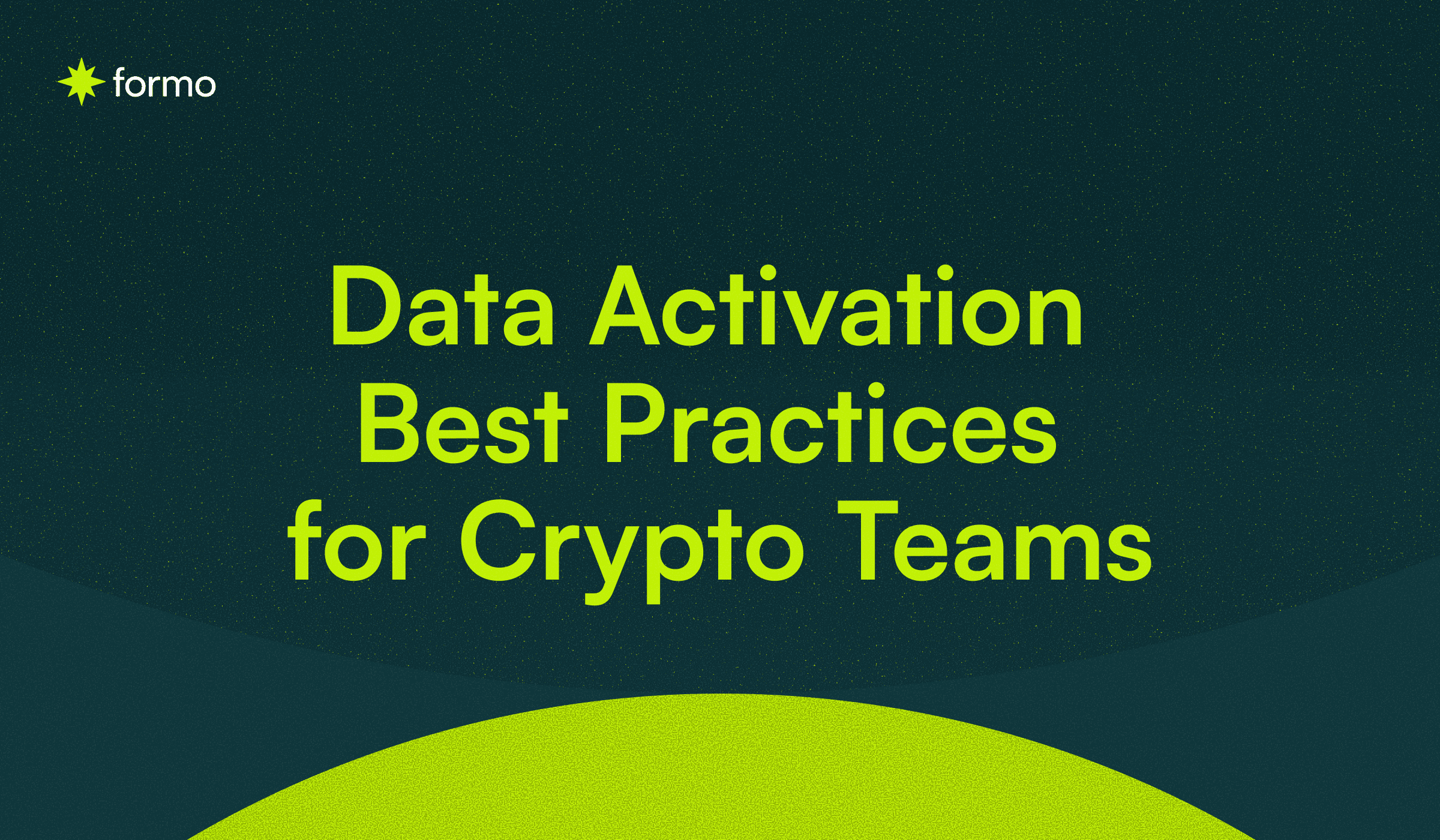What Is Data Collection: Methods, Types, Tools
Capturing and structuring user data is critical for personalizing marketing, supporting sales, and enhancing user experiences. With massive amounts of data generated daily, effective data collection tools and techniques offer valuable insights and a competitive edge. As data sources expand, so do the methods and technologies used for collection.
This guide will cover key concepts, tools, and best practices for creating an efficient data collection framework. With the right approach, data becomes a powerful asset for making informed, actionable decisions.
Key Takeaways
Data collection is critical for informed decision-making, marketing personalization, and user understanding.
There are two main types: quantitative (numeric, measurable) and qualitative (descriptive, in-depth).
Primary methods: surveys, interviews, A/B tests, analytics.
Secondary methods: existing data sources.
Tools like Google Forms, Qualtrics, and Formo simplify the process. Formo excels for Web3 use cases.
A strong data collection strategy supports segmentation, forecasting, and growth.

Data collection is the systematic process of capturing and measuring information from various sources
What is data collection?
Data Collection is the systematic process of capturing and evaluating information to address specific research questions or problems. It involves sourcing data to answer questions, assess outcomes, and predict trends.
Two Main Types of Data
Type | Description | Common Methods |
Quantitative | Numerical data is used to quantify behavior, trends, or results. | Surveys, A/B tests, web analytics |
Qualitative | Descriptive, non-numerical data is used to explore emotions, motivations, and opinions. | Interviews, focus groups, and open-ended surveys |
Why do we need data collection?
Data collection helps us understand, analyze, and make impact decisions. Data collection plays an important role in the success of any brand or project for several key reasons:
Customer Insights: Understanding user preferences and needs deeply, enabling brands to deliver more personalized and relevant experiences.
Targeted Marketing: By segmenting prospects effectively, teams can deliver more precise, automated marketing campaigns, increasing engagement and conversion rates.
Enhanced Decision-Making: Accurate data empowers better decision-making, offering insights that guide strategy and operational improvements.
Accurate Forecasting: Data collection enhances reporting and long-term planning by improving the accuracy of predictions, which supports better business growth and risk management.
What are the different data collection methods in tech?

Examples of data collection methods
Here’s a brief overview of the most common methods:
Method | When to use | How to collect data |
Experiment | To test a causal relationship | Manipulate variables and measure their effects on others |
Survey | To understand the general characteristics or opinions of a group of people | Distribute a list of questions to a sample online, in person, or over the phone |
Interview/focus group | To gain an in-depth understanding of perceptions or opinions on a topic | Verbally ask participants open-ended questions in individual interviews or focus group discussions |
Observation | To understand something in its natural setting | Measure or survey a sample without trying to affect them |
Ethnography | To study the culture of a community or organization first-hand | Join and participate in a community, and record your observations and reflections |
Archival research | To understand current or historical events, conditions, or practices | Access manuscripts, documents, or records from libraries, depositories, or the internet |
Secondary data collection | To analyze data from populations that you can’t access first-hand | Find ẽisting datasets that have already been collected, from sources such as government agencies or research organizations |
Primary Data Collection is gathered firsthand, directly from sources you engage with. This method is tailored to your research needs and offers unique, original information. Here are the specific methods:
Surveys & Forms
Surveys and forms are the easiest way to capture information that aligns with your users. There are two ways:
Closed-ended Surveys: Use predefined answers for straightforward analysis (e.g., yes/no, multiple-choice).
Open-ended Surveys: Allow respondents to provide detailed, qualitative responses, offering richer insights but requiring more complex analysis.
Pros: Efficient for large groups, easy to analyze, and cost-effective.
Cons: Potential for response bias, low response rates.
Interviews
Conducted one-on-one, these provide in-depth, personalized information. Interviews can be structured, semi-structured, or unstructured, depending on the research goals.
Pros: Rich, detailed data, opportunity for flexible follow-up questions.
Cons: Time-consuming, potential for interviewer bias, limited reach.
Focus Groups
Group discussions that capture diverse opinions and insights. Useful for exploring attitudes and behaviors, though results may be influenced by group dynamics.
Pros: Diverse perspectives and interactive discussions.
Cons: Group influence may skew individual responses, and managing group dynamics can be challenging.
A/B Testing
Compare two variations (A and B) to determine which performs better.
Pros: Clear insights, simple to run and analyze.
Cons: Needs high traffic, time-consuming, may oversimplify.
Web Visitor Analytics
Tracks and analyzes user behavior on websites in real-time.
Pros: Real, unbiased data on user actions. Useful for understanding actual behavior.
Cons: Time-intensive to analyze, can be limited in broader applicability.
Secondary Data Collection uses existing information collected by others, such as government reports, online databases, or research articles. It is ideal for gaining insights quickly without conducting original research.
Public Datasets
Information from external sources, such as government agencies or published reports.
Pros: Time-saving, often readily available, suitable for large-scale studies.
Cons: Variable data quality, limited control over the data collection process, and potential access restrictions.
Data Collection Tools

Data collection involves capturing both quantitative and qualitative data to support various analyses.
Technology can greatly enhance your data collection process. Key tools fall into two categories:
Data Collection:
These tools simplify the process of collecting data.
Tool | Description |
Simple, reliable, free | |
An advanced survey platform used in research | |
Web3-native form builder that supports onchain and offchain data collection |
Data Analysis, Visualization, Reporting:
These tools help process, interpret, and visualize data and generate reports.
Tool | Description |
Easy to use, great for basic analysis | |
Advanced data visualization for business intelligence | |
Visualize and export onchain user data from your surveys |
Challenges in data collection
Data collection empowers brands to gain valuable insights, but it comes with several challenges:
Low Response Rates: Surveys and interviews may suffer from low participation, reducing the representativeness of the sample.
Access Issues: Reaching niche or hard-to-access target groups can be difficult, which can limit the comprehensiveness of the data.
Data Quality Problems: Biases, inaccuracies, and incomplete data can undermine the value and reliability of the collected information.
Resource Constraints: Data collection efforts often face time and budget limitations, which can affect the scope and effectiveness of the process.
What are the key steps in the data collection process?
Data collection, much like constructing a building, requires careful planning and execution. Here’s a breakdown of the basic stages to ensure your data remains reliable and useful:
Define Objectives
What: Identify the specific research question or goal that will guide your data needs.
Why: Clear objectives ensure the data you collect is relevant and purposeful.
Select Methods
Quantitative or Qualitative: Choose appropriate methods based on whether you need numerical data (quantitative) or descriptive insights (qualitative).
How: Methods could include surveys, interviews, observations, or a combination, depending on your objectives.
Develop Instruments
Design: Create tools such as surveys, interview guides, and observation protocols tailored to your chosen methods.
Test: Pilot these instruments on a small sample to refine and improve them before full-scale data collection.
Collect Data
Implementation: Use your refined instruments to capture data from the entire target sample.
Management: Systematically store and organize the data, ensuring accessibility and proper categorization.
Process and Clean Data
Prepare: Clean the data by addressing missing values, errors, and inconsistencies.
Analyze: Process the raw data carefully to ensure accuracy and reliability in your analysis and findings.
Supercharge growth onchain with Formo
Unlock your growth with Formo, the Web3 analytics platform built for product and marketing teams. With Formo, you can:
Design flexible surveys using the Web3 Form Builder.
Collect both onchain and offchain data through social verification and token-gating.
Seamlessly export your data for deeper analysis.
Visualize Web3 data with Formo Analytics.
Data collection is more than just gathering numbers—it's about unlocking actionable insights that drive decisions, solve problems, and foster deeper understanding. By mastering these tools and techniques, you’ll ensure accuracy and reliability, empowering product and marketing teams to achieve meaningful progress.
Follow us on LinkedIn and Twitter, and join our community for more onchain growth insights.
Further source:
FAQs
1. What’s the difference between primary and secondary data?
Primary data is information you collect directly for a specific purpose, such as surveys, interviews, experiments, or direct observation. It is original and highly relevant but often time-intensive and costly to gather. Secondary data is information that already exists. It can come from government reports, industry research, academic studies, databases, or analytics platforms. While faster and cheaper to access, secondary data may not be tailored to your exact needs.
2. Which method is best for understanding users?
The best method depends on your goals. If you want to uncover motivations, pain points, and attitudes, qualitative approaches like interviews, focus groups, and open-ended surveys are most effective. To understand actual behavior at scale, quantitative methods such as web analytics, heatmaps, A/B testing, or blockchain data analysis provide measurable evidence of how users act. Many teams combine both for a complete picture.
3. How do I choose the right data collection tool?
Start by defining your research objectives and the type of data you need. For customer experience research, survey and feedback platforms may be ideal. For digital products, analytics tools help track engagement and conversion. In Web3, tools must also handle wallet verification, token-gated access, and onchain activity. For example, Formo supports social logins, integrates onchain and offchain data, and enables teams to build token-gated forms, bridging traditional and blockchain-native data collection.
4. What happens if data collection is poor?
Poorly executed data collection leads to biased or incomplete insights. This can cause inaccurate reporting, flawed decision-making, wasted resources, and missed opportunities for product growth. Inaccurate data also undermines trust with stakeholders, investors, and your community. High-quality, reliable data ensures strategies are grounded in reality.
5. How does Formo help Web3 teams with data collection?
Formo is built for the unique needs of Web3 teams. It simplifies wallet verification, tracks both onchain and offchain user behavior, and makes it easy to segment communities for research, airdrops, and campaign attribution. Instead of piecing together multiple tools, Formo provides an integrated platform where blockchain-native data collection meets familiar Web2 analytics practices.
6. What are the main types of data collection methods?
There are two broad types of data collection methods. Qualitative methods focus on open-ended insights from interviews, focus groups, and case studies. Quantitative methods collect numerical data through surveys, experiments, analytics platforms, or blockchain transaction monitoring. Choosing between them depends on whether you need depth of understanding or measurable evidence.
7. Why is ethical data collection important?
Ethical data collection protects user privacy, ensures transparency, and builds trust. Collecting data without consent or clarity can harm your brand and lead to legal or compliance risks. Especially in Web3, where anonymity and privacy are core values, ethical practices like opt-in forms and anonymized analytics are critical for user adoption.
8. What industries benefit most from data collection?
Virtually every industry benefits from systematic data collection. In e-commerce, it drives personalization and conversion optimization. In healthcare, it improves patient outcomes through evidence-based decisions. In finance, it enables fraud detection and risk assessment. In Web3, it helps teams understand wallet behavior, segment communities, and design more effective product and growth strategies.




